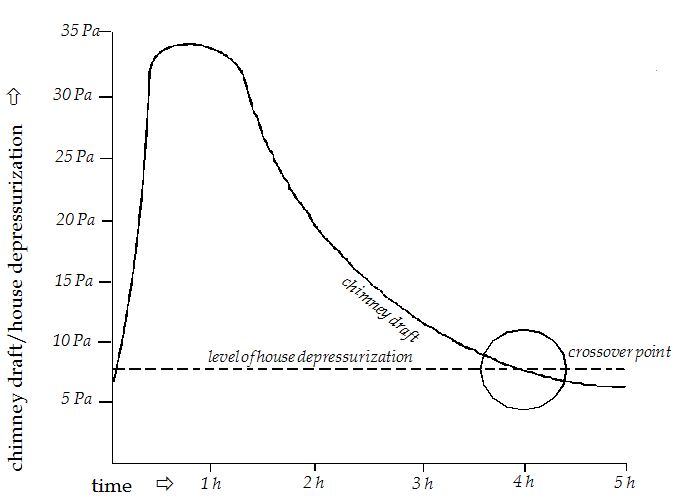Energy momentum
As a combustion cycle begins, hot gas rises through the system, producing draft and reducing the susceptibility to combustion spillage. Some of the heat produced at the beginning of the combustion cycle is absorbed by the materials of the appliance and venting system. As a wood fire recedes into the coal bed phase, the heat output and gas flow rates decline until combustion ceases completely. During this tail-out phase of the fire, the system becomes increasingly susceptible to combustion spillage if the room is depressurized. Part of the heat output of an appliance is stored in the materials of the appliance and venting system. When the fire recedes or cycles off, this stored heat energy is released and continues to produce draft in the system after combustion has ceased. The energy momentum created by the stored heat in the combustion appliance and chimney makes the system less susceptible to spillage during tail-out.
At the beginning of the combustion cycle the heat in the system causes draft to rise to almost 35 Pa. As the fire 'tails out' draft falls. If the house were being continuously depressurized by a large exhaust system, combustion spillage might occur when the driving pressure of chimney draft is exceeded by the adverse house depressurization. In this case the "crossover" occurred at about the four hour point in the combustion cycle. A greater amount of energy momentum in this system would have produced a crossover point that was later in the combustion cycle. The value of energy momentum "invested" in the system during a combustion cycle is dependent mostly on the mass or weight of the materials it is made of. The more massive the appliance and chimney, the more energy momentum the system will have. A masonry heater is an example of a system with very high energy momentum. The heat stored in the mass of the structure continues to produce strong draft long after combustion has ceased. This characteristic makes masonry heaters most resistant to spillage during tail-out. At the other extreme, a lightweight factory-built fireplace vented through an air-cooled chimney is an example of a system possessing very little energy momentum. The air cooling of the chimney liner would chill the flue gases throughout the tail-out period. Such fireplace/chimney systems are highly susceptible to spillage if the room is depressurized during the tail-out phase of the fire. Appliances certified by EPA as having low emissions fall somewhere between the examples cited above. EPA certified appliances tend to have firebrick lining or other forms of firebox insulation and/or internal structures like catalytic chambers to achieve low emissions. These features tend to create more mass and therefore energy momentum in these products. There is little you can do about the energy momentum characteristics of the fireplace or stove you select, but knowledge of the concept can be helpful in the diagnosis of spillage problems. Summary
|
